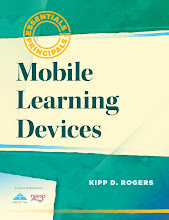Technology should never be the lead actor in the play. It should always be the supporting actor for good instruction. For example, if you are using cell phones in class, don't say to students, “Today we are going to do a cell phone activity”. Instead, you should say, “Today we are going to compare and contrast…”
Here are four critical mistakes that teachers make when integrating technology into instruction.
1. Becoming Masters of Technology. Thinking you have to master the technology before allowing students to use it. You do not have to be an expert with the technology before you allow students to use it (this is often just an excuse not to use the technology). Students will happily assist you.
 2. Being afraid that you will “break” the technology. Sure hardware can be broken if not taken care of properly. However, for the most part it is difficult to break something that is on the Internet—Web 2.0 tools. You are not going to break the technology.
2. Being afraid that you will “break” the technology. Sure hardware can be broken if not taken care of properly. However, for the most part it is difficult to break something that is on the Internet—Web 2.0 tools. You are not going to break the technology. 3. Thinking too big. Every student in your class does not have to do the same thing at the same time. Differentiate. Use small groups. Assign a project that can be completed outside of class. For example, students could be assigned a book report where they use Animoto to create a commercial that summarizes the book. Students can email the final product to you. Another idea is to consider soliciting help from another staff member or parent to help in the computer lab instead of going it alone with 25 students and 25 computers.
4. Not identifying the purpose. Sometimes we use technology for the sake of using technology (bringing the WOW factor into the classroom). The WOW factor does allow educators to leverage novelty to engage students. The problem with this is, many times we miss a real opportunity to develop technology integration pedagogy and teach 21st century skills. For example, if you have students work in groups to produce a Google Doc, I would think the purpose of that activity is not just to have students use a Google Doc to complete an assignment. The purpose should be to have students communicate, collaborate and think critically (three of the four Cs of 21st century skills- communicate, collaborate, create and critically think).



Great points! I would also add not allowing enough time for play and exploration to find out what technology can do before beginning the specific learning task.
ReplyDeleteAbsolutely!
ReplyDeleteFour excellent points made clearly and efficiently! Thank you.
ReplyDeleteHi Kipp, interesting points. I would also say take it slowly and focus on integrating a few things at a time rather than trying to do too much when you're not ready.
ReplyDeleteAlso I don't 100 % agree with Masters of Technology. For thing as simple as using Animoto or a simple online tool -- yes I would agree.
But for others it is important that teachers experience how differently you communicatem collaborate, create, critically think and learn when used well. The trouble can be if they haven't experienced this aspect, in some situations, it can lead to very poor use of it. We see this happen regularly with student blogging programs when educators haven't taken the time to increase their skills or take a more systematic approach to introducing it.
Excellent advice. Keep up the good work.
ReplyDeleteGreat advice. I think lots of us, even the more comfortable with technology, think too big sometimes and can forget the central message of learning.
ReplyDeleteTerrific advice. If we keep what you have said in mind there is a greater chance of continuing on and being that lifelong learner.
ReplyDeleteI give my students one month with any tool. They are in second grade, and have access to the laptops/lab twice a week. My experience is that less than a month makes it just an experiment, whereas more time with the tool makes it a resource for them to go to again independently.
ReplyDeleteGood points. I recommend Curtis Bonks book "The World Is Open" when he uses the concept that you can now learn anything, anytime, anywhere as a central theme. You can read a summary at http://bit.ly/dUcnDU.
ReplyDeleteDouglas W. Green, EdD
Great post.
ReplyDeleteI agree, too much emphasis is placed on the technology instead of deep learning. Too often tech integration is for technology's sake. A spotlight on tech to say "Hey, we're using tech in our classroom!"
edtechzone.blogspot.com
So very true. I would also add that some are too scared to even know where to start that they continue to use the same outdated teaching styles...
ReplyDeletePerhaps the biggest mistake is "Integrating Technology" in the first place. To me, that implies a static curriculum. You are right on in your last point: but I would like to take it another step further. Yes, collaboration and creation are noble, but for what purpose? Teachers must design lessons for authentic audience and purpose. By that I mean the creation of something must serve a purpose for the student OTHER than a grade, and the audience must be someone OTHER than the teacher.
ReplyDeleteIntegration didn't work in the 60's, and it won't work now.
great post! Communication, sharing, collaboration, audience, and discovery should be the main points of technology in the classroom!
ReplyDelete